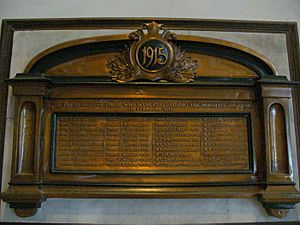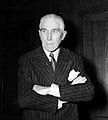Hindu–German Conspiracy facts for kids
The Hindu–German Conspiracy(Note on the name) was a series of attempts between 1914 and 1917 by Indian nationalist groups to create a Pan-Indian rebellion against the British Empire during World War I. This rebellion was formulated between the Indian revolutionary underground and exiled or self-exiled nationalists in the United States. It also involved the Ghadar Party, and in Germany the Indian independence committee in the decade preceding the Great War. The conspiracy began at the start of the war, with extensive support from the German Foreign Office, the German consulate in San Francisco, and some support from Ottoman Turkey and the Irish republican movement. The most prominent plan attempted to foment unrest and trigger a Pan-Indian mutiny in the British Indian Army from Punjab to Singapore. It was to be executed in February 1915, and overthrow British rule in the Indian subcontinent. The February mutiny was ultimately thwarted when British intelligence infiltrated the Ghadarite movement and arrested key figures. Mutinies in smaller units and garrisons within India were also crushed.
The Indo-German alliance and conspiracy were the target of a worldwide British intelligence effort, which successfully prevented further attempts. American intelligence agencies arrested key figures in the aftermath of the Annie Larsen affair in 1917. The conspiracy resulted in the Lahore conspiracy case trials in India as well as the Hindu–German Conspiracy Trial — at the time the longest and most expensive trial ever held in the United States.
This series of events was pivotal for the Indian independence movement, and became a major factor in reforming the Raj's Indian policy. Similar efforts were made during World War II in Germany and in Japanese-controlled Southeast Asia. Subhas Chandra Bose formed the Indische Legion and the Indian National Army, and in Italy Mohammad Iqbal Shedai formed the Battaglione Azad Hindoustan.
Background
Nationalism had become more and more prominent in India throughout the last decades of the 19th century as a result of the social, economic and political changes instituted in the country through the greater part of the century. The Indian National Congress, founded in 1885, developed as a major platform for loyalists' demands for political liberalization and for increased autonomy. The nationalist movement grew with the founding of underground groups in the 1890s. It became particularly strong, radical and violent in Bengal and in Punjab, along with smaller but nonetheless notable movements in Maharashtra, Madras and other places of South India. In Bengal the revolutionaries more often than not recruited the educated youth of the urban middle-class Bhadralok community that epitomized the "classic" Indian revolutionary, while in Punjab the rural and military society sustained organized violence.
Other related events include:
- the 1915 Singapore Mutiny,
- the Annie Larsen arms plot,
- the Jugantar–German plot,
- the German mission to Kabul,
- by some accounts, the Black Tom explosion in 1916.
Parts of the conspiracy also included efforts to subvert the British Indian Army in the Middle Eastern theatre of World War I.
Trials
The conspiracy led to several trials in India, most famous among them the Lahore Conspiracy trial, which opened in Lahore in April 1915 in the aftermath of the failed February mutiny. Other trials included the Benares, Shimla, Delhi, and Ferozepur conspiracy cases, and the trials of those arrested at Budge Budge. At Lahore, a special tribunal was constituted under the Defence of India Act 1915 and a total of 291 conspirators were put on trial. Of these 42 were awarded the death sentence, 114 transported for life, and 93 awarded varying terms of imprisonment. Several of these were sent to the Cellular Jail in the Andaman Islands. Forty two defendants in the trial were acquitted. The Lahore trial directly linked the plans made in United States and the February mutiny plot. Following the conclusion of the trial, diplomatic efforts to destroy the Indian revolutionary movement in the United States and to bring its members to trial increased considerably.
In the United States, the Hindu–German Conspiracy Trial commenced in the District Court in San Francisco on 12 November 1917 following the uncovering of the Annie Larsen affair. One hundred and five people participated, including members of the Ghadar Party, the former German Consul-General and Vice-Consul, and other members of staff of the German consulate in San Francisco. The trial itself lasted from 20 November 1917 to 24 April 1918. The last day of the trial was notable for the sensational assassination in a packed courtroom of the chief accused, Ram Chandra, by a fellow defendant, Ram Singh, who believed he was a spy for the British. Singh himself was immediately shot dead by a US Marshal.
In May 1917, a group of Indian nationalists of the Ghadar Party were indicted by a federal grand jury on a charge of conspiracy to form a military enterprise against Britain. In later years the proceedings were criticised as being largely a show trial designed to appease the British government. The jury during the trial was carefully selected to exclude any Irish person with republican views or associations. The trial lasted from November 20, 1917, to April 24, 1918, and resulted in the convictions of 29 people, including 14 Indian nationalists. British colonial authorities hoped the conviction of the Indians would result in their deportation back to India. Had the nationalists been deported to India, they would've faced much harsher sentences, including execution. In contrast to the mass executions in India, the Indian nationalists convicted in the San Francisco trial received prison terms ranged from 30 days to 22 months, as they faced far less serious charges of violating U.S. neutrality laws.
Strong public support in favour of the Indians, especially the revived Anglophobic sentiments following the provisions of the Treaty of Versailles which were perceived as being overtly favorable towards Britain, allowed the Ghadarite movement to be revived despite British concerns.
Impact
The conspiracy had a significant impact on Britain's policies, both within the empire and in international relations. The outlines and plans for the nascent ideas of the conspiracy were noted and tracked by British intelligence as early as 1911. Alarmed at the agile organisation, which repeatedly reformed in different parts of the country despite being subdued in others, the chief of Indian Intelligence Sir Charles Cleveland was forced to warn that the idea and attempts at pan-Indian revolutions were spreading through India "like some hidden fire". A massive, concerted, and coordinated effort was required to subdue the movement. Attempts were made in 1914 to prevent the naturalisation of Tarak Nath Das as an American citizen, while successful pressure was applied to have Har Dayal interned.
Commemoration

The Ghadar Memorial Hall in San Francisco honours members of the party who were hanged following the Lahore conspiracy trial, and the Ghadar Party Memorial Hall in Jalandhar, Punjab commemorates the Ghadarites who were involved in the conspiracy. Several of those executed during the conspiracy are today honoured in India. Kartar Singh is honoured with a memorial at his birthplace of the Village of Sarabha. The Ayurvedic Medicine College in Ludhiana is also named in his honour. The Indian government has produced stamps honouring several of those involved in the conspiracy, including Har Dayal, Bhai Paramanand, and Rash Behari Bose. Several other revolutionaries are also honoured through India and the Indian American population. A memorial plaque commemorating the Komagata Maru was unveiled by Jawaharlal Nehru at Budge Budge in Calcutta in 1954, while a second plaque was unveiled in 1984 at Gateway Pacific, Vancouver by the Canadian government. A heritage foundation to commemorate the passengers from the Komagata Maru excluded from Canada was established in 2005. In Singapore, two memorial tablets at the entrance of the Victoria Memorial Hall and four plaques in St Andrew's Cathedral commemorate the British soldiers and civilians killed during the Singapore Mutiny. In Ireland, a memorial at the Glasnevin Cemetery in Dublin commemorates the dead from the Jalandhar mutiny of the Connaught Rangers. The Southern Asian Institute of Columbia University today runs the Taraknath Das foundation to support work relating to India. Famous awardees include R. K. Narayan, Robert Goheen, Philip Talbot, Anita Desai and SAKHI and Joseph Elder.
Note on the name
The conspiracy is known under several different names, including the 'Hindu Conspiracy', the 'Indo-German Conspiracy', the 'Ghadar conspiracy' (or 'Ghadr conspiracy'), or the 'German plot'. The term Hindu–German Conspiracy is closely associated with the uncovering of the Annie Larsen plot in the United States, and the ensuing trial of Indian nationalists and the staff of the German Consulate of San Francisco for violating American neutrality. The trial itself was called the Hindu–German Conspiracy Trial, and the conspiracy was reported in the media (and later studied by several historians) as Hindu–German Conspiracy. However, the conspiracy involved not only Hindus and Germans, but also substantial numbers of Muslims and Punjabi Sikhs, and strong Irish support that pre-dated German and Turkish involvement. The term Hindu (or Hindoo) was used commonly in opprobrium in America to identify Indians regardless of religion. Likewise, conspiracy was also a term with negative connotations. The term Hindu Conspiracy was used by the government to actively discredit the Indian revolutionaries at a time the United States was about to join the war against Germany.
The term 'Ghadar Conspiracy' may refer more specifically to the mutiny planned for February 1915 in India, while the term 'German plot' or 'Christmas Day Plot' may refer more specifically to the plans for shipping arms to Jatin Mukherjee in Autumn 1915. The term Indo-German conspiracy is also commonly used to refer to later plans in Southeast Asia and to the mission to Kabul which remained the remnant of the conspiracy at the end of the war. All of these were parts of the larger conspiracy. Most scholars reviewing the American aspect use the name Hindu–German Conspiracy, the Hindu-Conspiracy or the Ghadar Conspiracy, while most reviewing the conspiracy over its entire span from Southeast Asia through Europe to the United States more often use the term Indo-German conspiracy. In British-India, the Rowlatt committee set up investigate the events referred to them as "The Seditious conspiracy".
Images for kids
-
Rash Behari Bose, key leader of the Delhi–Lahore Conspiracy and, later, of the February plot
-
Ghadar di gunj, an early Ghadarite compilation of nationalist and socialist literature, was banned in India in 1913.
-
Punjabi Sikhs aboard the Komagata Maru in Vancouver's English Bay, 23 May 1914. The Canadian government banned the passengers from landing in Canada and the ship was forced to return to India. The events surrounding the Komagata Maru incident served as a catalyst for the Ghadarite cause.
-
Franz von Papen, later the Chancellor of Germany briefly before Hitler's rise to power. Papen was key in organising the arms shipments.
-
Mahendra Pratap (centre) at the head of the Mission with the German and Turkish delegates in Kabul, 1915. Seated to his right is Werner Otto von Hentig.
See also
- Horst von der Goltz
- Hinduism in Germany








